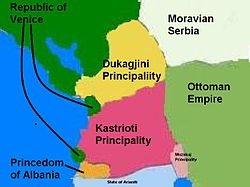Principality of Kastrioti
Pricipality of Kastrioti Principata e Kastriotit | |||||||||
|---|---|---|---|---|---|---|---|---|---|
| 1389–1444 | |||||||||
|
Flag of Skanderbeg | |||||||||
 Principality of Kastrioti in 15th century | |||||||||
| Status | Principality | ||||||||
| Capital | Kruja | ||||||||
| Common languages | Albanian | ||||||||
| Religion | Catholic | ||||||||
| Government | Principality | ||||||||
| Prince | |||||||||
• 1389-1417 | Gjon Kastrioti | ||||||||
• 1443-1444 | Gjergj Kastrioti | ||||||||
| Historical era | Medieval | ||||||||
• Established | 1389 1389 | ||||||||
• Fall under Ottoman Empire | 1417 | ||||||||
• Regained control | 1443 | ||||||||
• Disestablished | 2 March 1444 1444 | ||||||||
| |||||||||
Principality of Kastrioti (1389-1444) was one of the most important principalities in Medieval Albania. It was created by Gjon Kastrioti and then ruled by the national hero of Albania, Gjergj Kastrioti Skanderbeg.
Formation
Gjon Kastrioti had originally only two small villages, which probably emblem of the eagle family with a black two-headed, even if it can provide different interpretations. In short time John Kastrioti managed to expand its lands so as to become the undisputed lord of Central Albania. He married Voissava Kastrioti who born five daughters - Mara, then wife of Stefan Crnojević of Montenegro; Jela, then wife of Gjin (Gino) Musacchio; Angjelina (Angelina), then wife of Vladan Arianit Conmenus Thopia; Vlajka, then wife of Stefan Maramonte Balšić; Maritsa, then wife of Karol Musacchio Thopia - and four children : Reposh, Stanisha (Stanislaus), Kostadin (Constantine) and Gjergj (our George Kastrioti). Gjon Kastrioti was among those who opposed[1] the early incursion of Ottoman Bayezid I, however his resistance was ineffectual. The Sultan, having accepted his submissions, obliged him to pay tribute and to ensure the fidelity of local rulers, George Kastrioti and his three brothers were taken by the Sultan to his court as hostages. After his conversion to Islam,[2] he attended military school in Edirne and led many battles for the Ottoman Empire to victory. For his military victories, he received the title Arnavutlu İskender Bey, (Albanian: Skënderbe shqiptari, English: Lord Alexander, the Albanian) comparing Kastrioti's military brilliance to that of Alexander the Great.
Restoration of Gjergj Kastrioti
He was distinguished as one of the best officers in several Ottoman campaigns both in Asia Minor and in Europe, and the Sultan appointed him General. He even fought against Greeks, Serbs and Hungarians, and some sources say that he used to maintain secret links with Ragusa, Venice, Ladislaus V of Hungary, and Alfonso I of Naples.[3] Sultan Murat II gave him the title Vali which made him General Governor. On November 28, 1443, Skanderbeg saw his opportunity to rebel during a battle against the Hungarians led by John Hunyadi in Niš as part of the Crusade of Varna. He switched sides along with 300 other Albanians serving in the Ottoman army. After a long trek to Albania he eventually captured Krujë by forging a letter[1] from the Sultan to the Governor of Krujë, which granted him control of the territory. After capturing the castle, Skanderbeg[4] abjured Islam and proclaimed himself the avenger of his family and country. He raised a flag showing a double-headed eagle, an ancient symbol used by various cultures of Balkans (especially the Byzantine Empire), which later became the Albanian flag. The Governor was killed as he was returning to Edirne, unaware of Skanderbeg's intentions... Skanderbeg allied with George Arianite[5](born Gjergj Arianit Komneni) and married his daughter Andronike (born Marina Donika Arianiti).[6]
League of Lezha
Following the capture of Krujë, Skanderbeg managed to bring together all the Albanian princes in the town of Lezhë[7] (see League of Lezhë, 1444). Gibbon[4] reports that the "Albanians, a martial race, were unanimous to live and die with their hereditary prince" and that "in the assembly of the states of Epirus, Skanderbeg was elected general of the Turkish war and each of the allies engaged to furnish his respective proportion of men and money". With this support, Skanderbeg built fortresses and organized a mobile defense force that forced the Ottomans to disperse their troops, leaving them vulnerable to the hit-and-run tactics of the Albanians.[8] He managed to create the League of Lezha, a federation of all Albanian Principalities.
See also
References
"History of Albanian People" Albanian Academy of Science. ISBN 9992716231
- ^ a b James Emerson Tennent, 1845, The History of Modern Greece, from Its Conquest by the Romans B.C.146, to the Present Time
- ^ Rendina, Claudio (2000). La grande enciclopedia di Roma. Rome: Newton Compton. p. 1136. ISBN 88-8289-316-2.
- ^ Noli, Fan S.: George Castrioti Scanderbeg, New York, 1947
- ^ a b Edward Gibbon, 1788, History of the Decline and Fall of the Roman Empire, Volume 6, Scanderbeg section
- ^ Fine, John V. (1994). The Late Medieval Balkans: A Critical Survey from the Late Twelfth Century to the Ottoman Conquest. ISBN 0-472-08260-4.
- ^ Titolo pagina
- ^ Minna Skafte Jensen, 2006, A Heroic Tale: Marin Barleti's Scanderbeg between orality and literacy
- ^ Stavrianos, L.S. (2000). The Balkans Since 1453. ISBN 1-85065-551-0.

